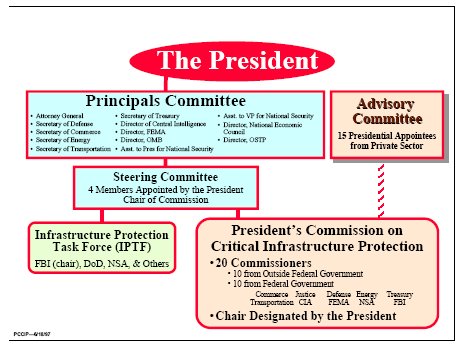
Power Structure for a Coup
On July 15, 1996, President Bill Clinton signed
Executive Order 13010
to establish the President's Commission on Critical Infrastructure. The
Order declares:
Certain national infrastructures are so vital that their incapacity or destruction would have a debilitating impact on the defense or economic security of the United States. These critical infrastructures include telecommunications, electrical power systems, gas and oil storage and transportation, banking and finance, transportation, water supply systems, emergency services (including medical, police, fire, and rescue), and continuity of government. Threats to these critical infrastructures fall into two categories: physical threats to tangible property ("physical threats"), and threats of electronic, radio-frequency, or computer-based attacks on the information or communications components that control critical infrastructures ("cyber threats"). Because many of these critical infrastructures are owned and operated by the private sector, it is essential that the government and private sector work together to develop a strategy for protecting them and assuring their continued operation.

|
|||
|
Sec. 2. The Principals Committee. The Commission shall report to the President through a Principals Committee ("Principals Committee"), which shall review any reports or recommendations before submission to the President. The Principals Committee shall comprise the:
(i) Secretary of the Treasury;
|
||
|
|||
Robert T. Marsh, Chairman,
President's Commission on Critical Infrastructure Protection
Merritt Adams, American Telephone & Telegraph (AT&T)
Richard R. Case, International Business Machines Corporation (IBM)
Mary J. Culnan, Ph.D, Georgetown University
Peter H. Daly, Senior Advisor in the Office of the Assistant Secretary for
Management and Chief Financial Officer
John C. Davis, National Security Agency
Thomas J. Falvey, Department of Transportation (DOT), Office of the Secretary,
Office of Intelligence and Security
William J. Harris, Ph.D., Texas Transportation Institute
David A. Jones, Office of Safeguards and Security, Director, Policy, Standards
and Analysis Division
William B. Joyce, Central Intelligence Agency (CIA)
Stevan D. Mitchell, Department of Justice
Irwin M. Pinkus, Ph.D., J.D., Department of Commerce, Bureau of Export
Administration
John R. Powers, Ph.D., M.Div. Ph.D., M.Div. FEMA, Policy Advisor for Strategic
Planning
Paul Rodgers, J.D., National Association of Regulatory Utility Commissioners
Susan Simens, Federal Bureau of Investigation (FBI)
Frederick M. Struble, Ph.D. Board of Governors of the Federal Reserve System
Nancy J. Wong, Pacific Gas and Electric Company (PG&E)
Jamie Gorelick, Co-Chair
Senator Sam Nunn, Co-Chair
Maurice Greenberg
Margaret Greene
Erle Nye
Floyd Emerson Wick
Sharon Sayles Belton
David Campbell
Charles Lee
Elvin Moon
Norman Mineta
Jeffrey Jaffe
Joseph Holmes
Robert Baxter
Mort Topfer
Jerome Davis
Robert Berdahl
Notes:
Mr. Mineta, of California, is Senior Vice President and Managing Director of Transportation Systems and Services at Lockheed Martin IMS. A former Mayor of San Jose, California, Mr. Mineta was elected to the U.S. House of Representatives in 1974, where he served for 21 years. While in Congress, he served as Chairman of the House Committee on Public Works and Transportation. Among his many contributions to U.S. transportation policy, Mr. Mineta oversaw airline deregulation during the 1980's and co-authored the Intermodal Surface Transportation Efficiency Act of 1991. He holds a bachelor's degree from the University of California at Berkeley.
Mr. Maurice R. Greenberg of New York, New York, currently serves as Chief Executive Officer and Chairman of American International Group, Inc. Mr. Greenberg joined AIG in 1960 and was elected President of its American Home Assurance Company subsidiary in 1962. He is a past chairman of the Federal Reserve Bank of New York, and is a current member of the Board of Directors of the New York Stock Exchange. He received his pre-law certificate from the University of Miami and an LL.B. from New York Law School.